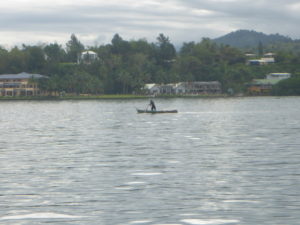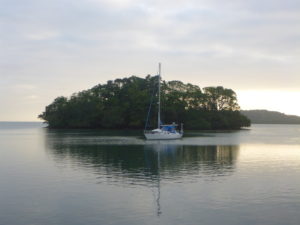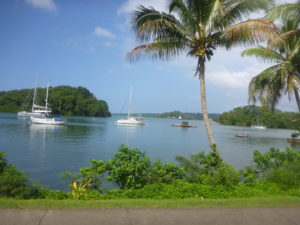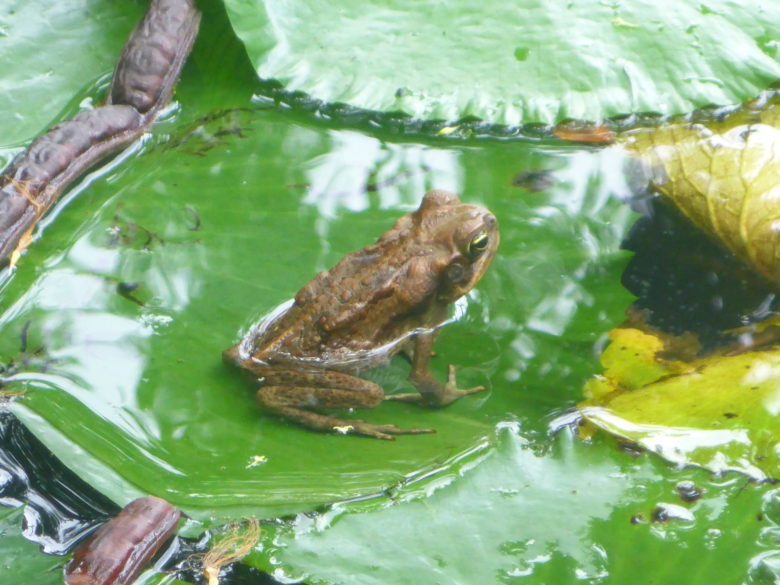Pearl Resort in Pacific Harbour
The first six photos show the recent investment in the Pearl Resort comprising a very posh reception area and a three floor accommodation building curving around the small marina like the globe glass of a goldfish bowl and Zoonie was one of the goldfish. (18:15.62S 178:04.29E)
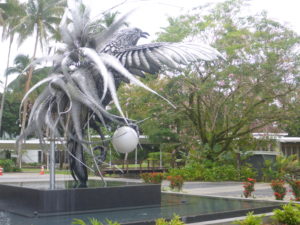


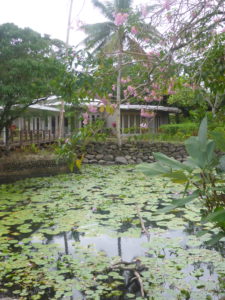


“I must remember my port from my starboard,” a beaming Frank apologised once we were nicely tied up. Rob had asked him ‘which side to’ to put our lines and he said “Port”, so when we arrived there he was on the starboard side pontoon of the space. Port side to him I guess!
Millie came aboard and we signed a form and paid for one night. Rob was looking forward to a few nights of marina comfort with the hope we would be able to hire a car here and visit The Sleeping Giant Gardens leaving Zoonie in total safety from the ever changing elements. That proved impossible but I will explain that later.
A wedding was in full swing when we arrived, the bride being conveyed from beneath the wings of the great silver bird at the hotel entrance, to the secluded modern events building overlooking the Beqa Channel with Beqa Island and Yacuna in the distance, aboard a golf trolley with two of her bridesmaids clinging on to the top precariously as the trolley rode up a slight hill.
We were watching from the bar area, elevated and behind the shapely swimming pool full with gleeful children.
The day was overcast with darker clouds threatening rain and I felt sorry for the bride, “I wonder where she has come from with her entourage hoping for the perfect Fijian wedding?” The word Fiji is synonymous with blue skies and waving palms; well she had the latter in the rising wind.

The next morning was Sunday and as we had been told the car hire desk would be open we wandered across hoping the arrangement would be a formality. ‘Sleepy Head’ was on duty. Either she was the life and soul of the party the night before, or she had had an incredible night in other ways or she was working off the drugs. Rubbing eyes and lazily pinning back her hair she barely showed any interest in us.
We heard the now familiar story of the nice little economical car being unavailable, so why don’t they have more and why can we not pay the same for whatever box on wheels is awaiting a spin. By a number of not previously mentioned additional costs she suddenly came to life with the words “That will be $247 for the day.”
“No it won’t,” I said aghast and glancing at Rob’s astonished expression we thanked her for her efforts and rose to leave. She smiled, closed her eyes and went back to her dreams.
We decided to wander down to the Pacific Harbour area of buildings and gardens just down the road for lunch and revise our plans over a glass of wine.
Around the year 1970 an ambitious and expensive concept was built in the form of two story buildings with shops and restaurants below and apartments above, around extensive water-gardens giving a Willow Pattern scene. It was built to encourage locals and expats to populate it and this probably happened for twenty years or so. I imagine it was a government sponsored scheme at the time. The Indian owned supermarket proudly sponsored the local school, not the maintenance of the Fijian cultural buildings.
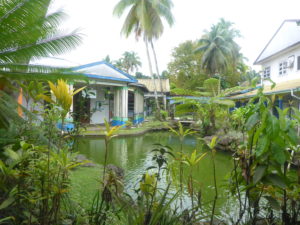
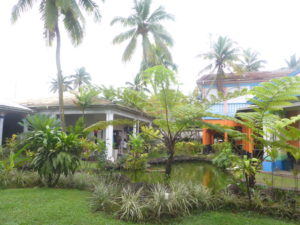
A Fijian lady was sitting on a bench outside the shop she has owned and run there for 34 years. While Rob restocked his wallet from the ATM I chatted with her. She originated from the biggest village on Matuku and knew all about the occasional re-appearance of Burotu Island. “You’ve actually seen it rise up?” I asked.
“No, not me but my ancestors did!” Her family is spread far and wide now and the shop is her livelihood and conduit for human contact.
Wandering further in to the labyrinth of shops and water lily ponds we noticed how the wood is rotting underneath peeling paintwork. What was once a substantial and wide wooden ramp leading up to the first floor (maybe for wheelchairs) was now broken with rot and cordoned off, so the entire upstairs of one building was derelict.
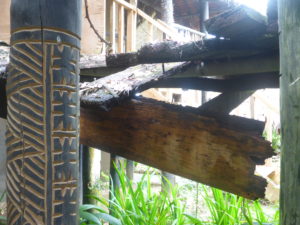
Out back the waterway became a lake surrounding an artificial fortified hill (imagine the cost of landscaping that) topped with a fine typical Fijian chiefs meeting house. Cultural events were once held here but although nature still thrived there was litter in the water, broken pipes, closed bridges and walkways and a general feel of human interest having moved on.

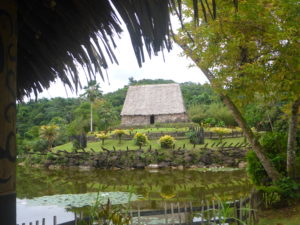
We awaited our light lunch while sitting overlooking a vast pond. Coaches and hire cars stop by for some food and shopping as Pacific Harbour is conveniently sitting beside the main Suva to Nadi road. Remember I mentioned the surf and dive centres bring people to the Beqa Lagoon from the mainland, well their shops and offices were here. So while the original intention for building this place did not last it seems that the advent of adventure and high thrills tourism may be its saviour. It seems to be at the moment.

Back at the marina/ hotel we sat with two Jehovah’s Witnesses for happy hour that night. One was originally from Italy, married a New Yorker from the Bronx who had died two years ago and the other with her husband used to own the resort we anchored off in Malumu Bay a few nights before, but didn’t seem to want to discuss it. They remember when there were cultural events in the Pacific Harbour village, but no more for these two expats.
With the promise of a serious blow arriving in the next few days we decided to move on to Lami Bay anchorage in Suva Harbour. It is a tiny bay tucked away from the main shipping area and right next to the main road, so we thought we’d be able to get in to Suva easily if we wanted. The marina was not expensive, $50 per night (£19) but then anchoring was free.
Millie arrived just after 6.00am the next morning to help us with our lines, well actually to give us our £1.53 electricity bill and she told me the cheapest rooms on the best deal in the low season were around $250 and past visitors preferred the old accommodation block with its bigger, homelier rooms overlooking the sea.
The entrance to the river is very narrow and shallow and that was why we were leaving on the 6.00am high tide. Grey clouds were scudding across above us and the water was bouncy even in the lagoon, the full force of the south easterlies blowing our way.
Safely through our generous gap in the barrier reef we turned east towards Suva when something caught my eye. High and dry on a reef and lying at an angle of around 40’ to the horizontal was a yacht, facing outwards towards us with its mast still attached. So it cannot have been there long. Rob contacted Suva Harbour Control to report the name of the reef and our position while I took Zoonie over to see if there was anyone needing a rescue.

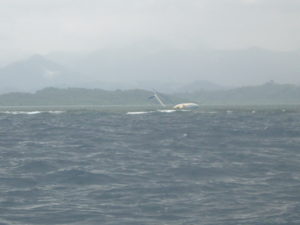
What I thought looked like a yellow anorak turned out to be a rust stain on the hull. With Zoonie hovering a few metres from the reef edge it became clear there was no one on board so we resumed our course. ‘Ivy Rose’ who was the only other cruising yacht in the marina came on the radio,”Zoonie, Zoonie, we followed you out of the marina, is it you that is in trouble on the reef?” Rob put him right and as they were bound for Kandavu their course was diverging from ours rapidly, but he would have come to help of course.
Later he told us the ferro yacht had been bought by an Indian who had paid a skipper to take it somewhere and that person had promptly run her aground about a month ago. I wondered if the skipper was more used to pangas that draw a few inches!
So here we are in our pretty little bay with its evening migration of fruit bats to watch. We have been invited to ‘Me Too’ for drinks tonight and yesterday afternoon we made our first attempt at finding the local waterfall. We will try again later.
Yesterday morning we walked the 20 minutes to Lami Village and found a market, supermarkets, a bakery, butcher, fish shops and a very well supplied yacht shop. In fact all we need except Customs and Immigration for clearing out.
Rob surfed the internet and found the timetable for the express bus service to Nadi Airport from which we can get a taxi to the Gardens of the Sleeping Giant but first we have more wind and rain coming and will remain with Zoonie until we get a calm, sunny day.
Close encounter with Seasnakes and Bountiful Rainwater
It is easy to fill one’s time here in Lami Bay, (18:06.53S 178:23.71E) both on board as the rain thunders down and ashore. Our two big white buckets are doing valiant service collecting water from the forward cover that hangs over the forehatch so we can have it open for ventilation. Rob is the water gatherer aboard and we are almost keeping up with our water usage just from rainwater.
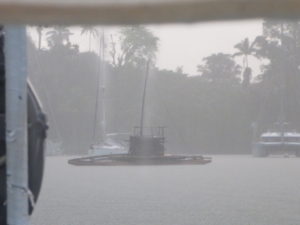
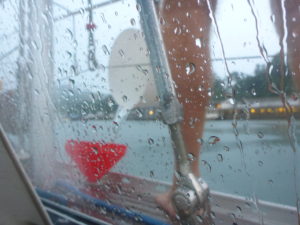
I have been busy putting more blogs onto my WordPress site and we both have numerous chores to do on board, just as you have with a house.
When the weather clears we motor ashore to visit Suva or Lami just down the road. The bus service is perfect with buses arriving every 15 minutes or so and the fares are so cheap that it is always hard to find two seats together as the buses are full, but that often causes a nice encounter with a local.
I sat next to a lady the other day, squeezing onto our seat for two that was obviously built when folk were smaller or it was a school bus, should be just enough room on there for me I thought. We started chatting as if we were regulars. The bus slowed into the stop in Lami, “Look at that” she said “Just look at her”. So I did look at the large young lady sitting on the bench and then looked at my companion. “She should be walking, get rid of some of that fat. I never want to get like that,” my greying haired companion concluded.
On another sortie ashore we had just arrived and Rob reached round the back of the outboard to the clip that lifts it up and started chuckling. A baby seasnake had climbed up to the ledge under the motor for a snooze and Rob’s hand brushed on it. It wiggled and squirmed in the bottom of the boat while I shimmied onto the pontoon with the painter to attach us you understand. “Use the bailer” I suggested from my safe vantage point, I am such a coward when it comes to snakes. Rob was still chuckling as he grabbed the little plastic scoop and helped the snake over the side.
The purpose of this trip was to visit the Australian Immigration Office and ask a few questions about our visa, (and they were very helpful) to enjoy a coffee somewhere and to buy a few items in the market. Rob noticed that the latest Johnny English film was showing at the multiplex cinema. The photo shows the Art Deco entrance to one of the malls.

We completed our errands in the time before the film was due to start and joined the crowd shuffling into the small room. There were few seats left empty when the film started amidst the munchings of popcorn and sucking on Cola straws. The audience ranged from young children to include their grandparents.
What a pleasure, a real touch of home and British humour for us but for the locals here the humour really touched the spot. The audience erupted so many times through film that the laughter had a unifying effect. Sometimes it would roll on from one joke to the next, now I know why films are on so loud. “Is that man snoring behind me?” Asked Rob, and he was bless him, fast asleep for the duration. Just like me when I took Emily to see The Lion King on stage in London, well it was Friday evening after a week’s work and a drive up from Lymington and the theatre was hot.
Bof, Johnny’s sidekick in the film, used the line “I have a plan” which was a nice reference to Baldrick in Blackadder, the series we have just finished. In one of the interviews with Rowan he said of himself that he rarely smiles or laughs himself and this is so true, it is partly his straight (or distorted) face that adds to the humour. See if you recognise the lady learner driver in the film.
Now weatherwise we are starting to look at the trends in the big patch of water between here and NZ. I was working away at the computer the other day when an item of news came up, either on Facebook or my BBC news app about the earliest cyclone in 68 years just establishing itself in the southern Solomon Islands to the north of here. It was heading west for New Guinea and had been given a category 1 (34 – 47 knots of spin) rating which is a gale to severe gale on the Beaufort scale.
We watched it moving slowly forward as they do at 6 to 17 knots and after a couple of days they downgraded it to a severe tropical storm. We heard nothing of it on the news as Indonesia was still taking up the headlines after the tsunami there.
So my questions were; was it going to be the first of more to come and what direction would subsequent ones take? Questions that can only be answered if they happen.
Fortunately for us this time pumping the rainwater out of Zoonie was part of the routine and there was never more than a few pints in the bilge under the sink. But not so for our neighbour, Lay Lady Lay, a bedraggled yacht of former beauty lying to anchor in here for a long time, her owners presumably more interested in their land life now. They turned up to bale her out, the lady down below passing many full buckets up to the man who, threw water back to where it had come from, judging by how the red muddy bucket water perfectly matched where he was throwing it.
Alongside the police pontoon where we leave the tender is a fine ketch, Antares of Gotland (Sweden). Drugs were found on board so she is sitting out her sentence taking up valuable working space. A two inch bore pipeline was spewing water out from her, the pump powered by a car battery, but it was clear rainwater most likely leaking through her decks.

The first day we had planned to take the long trip to the Gardens of the Sleeping Giant was abandoned as the rain thundered down. Instead I read a remarkable book, the ‘Narrative of the mutiny’, Captain William Bligh’s mutiny on the Bounty and his own log of the 41 days it took him and his 18 men to sail in their 23 foot boat from Tofoa near Tahiti to a Dutch colony in Timor, in the East Indies between May and June 1789. There was no reference to an editor, no acknowledgements or index just the daily entries of their tale of survival in a hostile environment and six notes at the end. A fascinating read for a rainy day.
We finished that day with a meal at the Novotel Hotel that overlooks the bay and more especially, Zoonie. One of the waiters came along lighting the gas torches and we chatted briefly. “Bring her closer, you could tie up here” he joked, caressing the railing under his hand. The hotel used to be more open to cruisers and was formerly called Tradewinds. Despite this the staff are welcoming and friendly. The meal was bountiful and we both struggled to finish the pile of roasted cassava, being used to smaller portions.
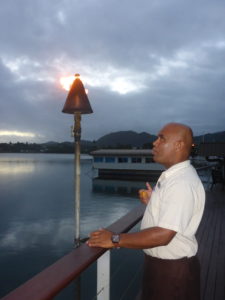
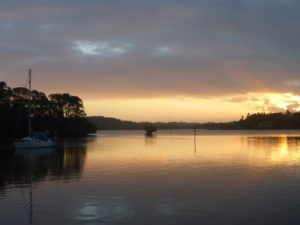

To the Garden of the Sleeping Giant
I say ‘To’ because the journey there and back to Zoonie was an integral part of the day. Lami Bay awoke under pearl pink skies and Suva’s lights were still bright in the gap between a wooded island and the small promontory dotted with detached homes that marks the eastern end of our bay. We motored to the Police compound, our landing place at the other end of Lami Bay.
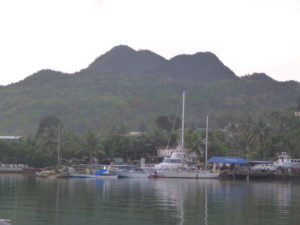
By 7.20am we were washed, breakfasted and standing beside the bus stop beneath a tall tree in which the barking pigeons were making their warm rounded woofing sounds. The local buses are vintage, goodness knows how old but I wouldn’t be surprised if they were on the road when I was born. Lots have no windows, just plastic sheets the traveller can tug down if it starts raining. They are tough, they must be to carry full loads all day, seven days a week, year in year out. They fill up with happy people, off to school or work or just on a shopping trip and they are essential because a mobile population is a happy population and where most Fijians will never be able to afford a car they can afford the 40p into town.
So we were curious to see how much the sleek grey fleet of modern long distance coaches cost to go from here along the 4 hour journey to Nadi Airport, £5.76 each. Again the coach was almost full and we sat separately for the first part of the journey along the south coast of Viti Levu where just a short distance from the main town the lifestyle of the Fijians reverted to the simple village life we had seen all over the islands.
Well-kept vegetable gardens, neat homes, a stand by the road for selling fresh produce, small fishing boats bobbing on rock anchors or tied to plastic bottle buoys, dogs romping along on a mission and folk bent double tending their crops.
The coach had efficient air conditioning but the Fijians find it too cold so as time passes the little vents above their heads are closed leaving just our two aiming localised cool air down on us. After a few passengers alight at their destinations I go and join Rob and our journey continues in happy silence with the occasional comment until we arrive at the modern airport terminus and relish the cool air on our walk to the loos. No eating, drinking, peeing or anything else is allowed on the hallowed coaches, just breathing, sitting and looking!
The Indo-Fijian taxi driver chatted to us about his home in the area as he drove us the 15 minutes to the gardens, the last part up a bumpy rough track. “I will wait for you.” We agreed on a time that would give us one and a half hours and save him three more runs along the rough track and some fuel. He turned in to what he remembered as the entrance but the road was closed. A vehicle driver behind us explained there was a newer entrance further up the hill.
The main building was wooden, high roofed and shady. White painted dining and easy chairs dotted the room. Our timing was perfect as the main tours are mid-morning and mid-afternoon so we were among the very few there. I wonder if Raymond Burr had thought of the appeal of his garden being enhanced considerably by its location so near the airport when he decided to bring his own collection of orchids here in 1977.
One of the gardeners greeted us and noting the grey skies further inland handed Rob a big umbrella, “You might need this my friend”. For less than £7 each the pretty vista unfolded. The concept reminded me of Heligan Gardens in Cornwall just behind Mevagissey. There a fine house was built atop the valley and gardens laid out down the irregular valley shape. Raymond’s own villa was just a few miles away but this idea of using the rugged, sheltered walls of a small valley for a garden was just the same.
We wandered slowly up the wooden boardwalk tunnel, with a rockery on the right and a roof and left wall of black mesh. His orchids were in concrete pots standing in the rockery, orchids so like to be confined don’t they, and lighter baskets hanging from supports on the left. One favourite of mine was the little blue topped and eared flower that appears to be sticking its white tongue out at the viewer. It’s the last picture in this group.
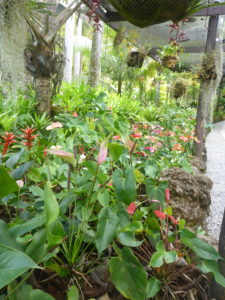
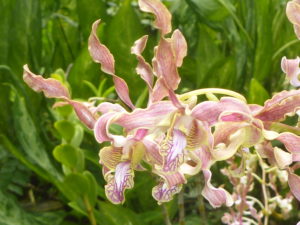
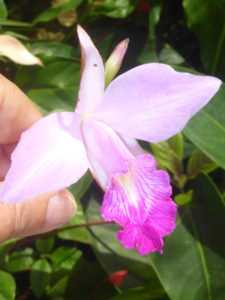
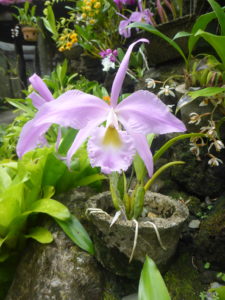
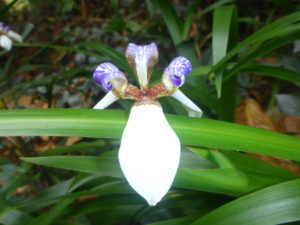
A flourishing fuchsia-coloured bougainvillea languished on the netting roof and caused it to bend under the weight and further up another, this time growing on the inside, pushed upwards through the netting.
At the top of this rise we had our first clear view of the Giant’s head on the skyline facing the sky, his gently rounded forehead on the left, then his nose and mouth to the right and the sky his blanket. Whether Raymond found this himself or was shown it I do not know but it cannot be seen from the vehicle track as it is lost against higher ground, so he must have climbed up the valley in the early days, negotiating the ravine and numerous composite volcanic boulders before deciding to buy the section.
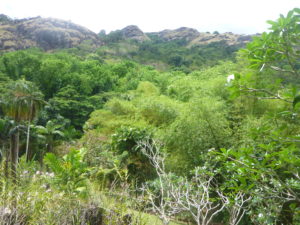
The brochure referred to the ‘cool’ valley and indeed the moisture that keeps the foliage so lush here, despite this being the dryer side of the island, will have come from cool sea air meeting the warmer air off the land and condensing into penetrating, saturating mist. But today it was hot and humid with another spell of thunderstorms brewing. We were fortunate to have blue skies and sunshine.
‘I like it here in my pond with all my buddies around me. We frogs sit on our lily pads all day long watching folk taking photos of us and looking all around them. We love water and so do these two walking down towards us now. During a day we will probably hop around our pond maybe twice but these two, well they like water as well and they are hopping around the big pond. I wouldn’t like that, too deep and not enough flies. Excuse me I think I will move, I appear to be sinking’. See me in the feature photo.
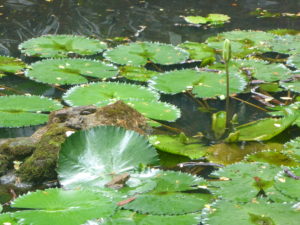
The water was only a few inches deep in fact, that’s all it takes to create an area in which nature can run riot and create such beauty. I took Emily to Monet’s garden in Giverny when she was almost a teenager. We had to cross a small road infront of his house and formal garden to find the water-garden. Monet had bought a small area of land at the side of a field with a little stream running through it from the local farmer and built a little dam and overflow system and then created his semi-natural wonder in less than a half metre of water. Arching willows, Japanese bridges and a riot of water plants, quite lovely.
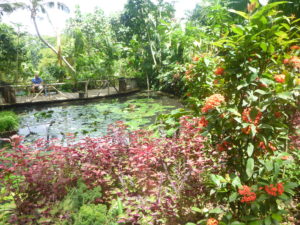

A little further on we detoured right to follow the native forest walk and along it there were numerous little paths that led nowhere but one, or two visitors could venture up them and around the curve at the end to really feel ‘lost’ in the jungle, or to hide from your playmate, imagine oneself miles from anywhere or steal a kiss.
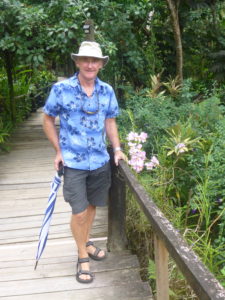
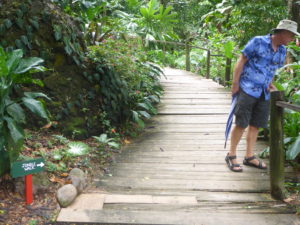
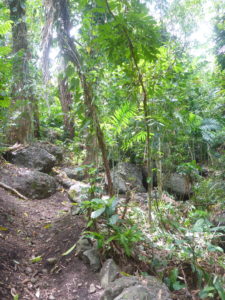
A deep streambed had been dry for a while, in it grew red stemmed plants their roots pushing deep for moisture. In this deliciously rustic place we came across a long wide rise of steps carefully painted white and leading up to a traditionally shaped Fijian meeting house with its high roof and walls made entirely of supported green foliage. The stairway was bordered with lush reddish plants and would be a fantastic venue for a wedding.
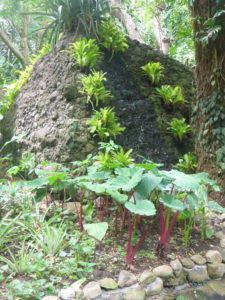
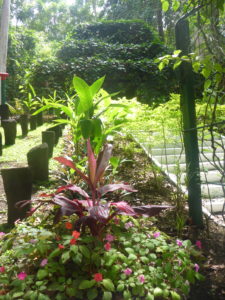
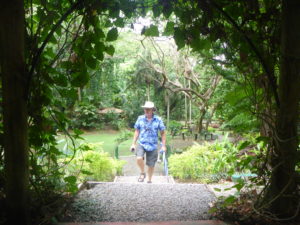
All sorts of questions arose in my mind which we could have asked had we been on a guided tour. Also we would have learned a lot more, but because there were so few of us taking in the gardens at our own pace the experience was an aesthetic one rather than educational. The gardens are small and intimate so one can whizz through or linger all day for a picnic near the pond with sturdy swings nearby for the children of all ages to play on and of course those little paths with their many uses.

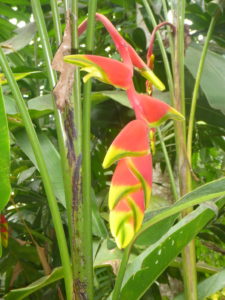
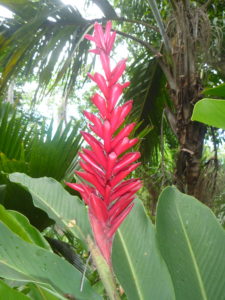

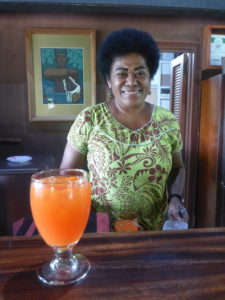
We had quite a while between meeting our taxi and meeting the coach so the taxi driver said he would take us on a little tour up the valley where he grew up, past his neat home sitting in its own garden. “That was my school, it had its centenary this year.” We had agreed a price at the start, $50 instead of $60 if he had come back to the gardens to collect us and he threw in his entertaining family history as an act of hospitality. One of those pleasant unexpected surprises.
I had another pleasant surprise on the coach. I sat down next to a middle aged lady and across the aisle from Rob, best of both worlds. We started a non-stop conversation that lasted for two hours before Rob’s neighbour left the bus and my neighbour said “I don’t mind if you go back to your husband now”. I was torn as it’s not often I get the chance for a good natter with a local.
We also moved to seats further forward as we had asked the bus driver if he would stop at the Novotel rather than us having to go all the way to Suva only to come back out again and we wanted to be able to remind him. So when we stopped again I slipped back to her to explain we had moved to be nearer the front to get off and when the coach next stopped she came forward, tapped my arm and said “Safe journey to New Zealand”.
Now in the last blog you will have seen the little wooden plank we have to negotiate from the tilting rotten pontoon onto the concrete harbour wall. It’s no problem around high tide and when it is dry but on this occasion it was low, low tide and damp. Rob went down first and as I waited I noticed two of the night shift policemen emerging from the shadows of their gazebo ready to assist if necessary. I dragged my thoughts back from sea snakes and dirty water to the centre line of the steep and twisted plank. First foot on and let it slide down to the wooden cross piece, then commit knowing there were three strong men ready to fish me out if needed.
Arms out as if walking a tight rope and keep that balance. Once I was over the watery gap I was fine and on stepping onto the soft wood I turned, waved and whispered “Vinaka” (thank you) to the receding figures. The end of another perfect day.
Last Few Days in Lami Bay
They were spent victualling up with Gas and Diesel from Lami Bay with the help of taxis and an obliging gas supply employee who drove us to the Fiji Gas people and then back to Zoonie with our four cylinders topped up.
We made a penultimate trip into Suva to buy fabric, flowers a cannibal fork and other gifts for future use, had a cheapy lunch at the massive MHCC shopping mall top floor and then, for a treat, went to see ‘A Star is Born’, with Lady Gaga and Bradley Cooper, American filmmaking at its best with up close camera work a window on the emotions, the evil of Lady Gaga’s manager and her beautiful soulful singing combining to give us a real treat. The pathos of the ailing star’s encroaching deafness reminded me of Beethoven’s similar burden when towards the end of his life he could only hear his music in his head.
The next day we went in between heavy showers to Lami for a last shop for chocolate and rum, and to post a birthday card home. We couldn’t believe how cheap it was to send a card airmail from Fiji to the UK, just 70p.
Climbing up the gangplank to the harbour wall was not too difficult but I was dreading our return as the wooden plank would be very steep down and slippery wet. In fact it glistened with rain as it descended onto the soaked pontoon, itself collapsed at one corner. As I looked down there was a watery, diesel slicked gap of 2 metres between the pontoon and the concrete harbour wall. I turned away and looked to the shore to see if Rob could bring the tender around to the beach when a sturdy hand took mine.

“Wait I will go down first,” said the young overalled policeman. Firstly he moved the top of the plank so it lost its suicidal twist in the middle. Even he was extremely cautious in his unlaced working boots. He stood around a third of the way down and again took my hand giving me a firm grip. Together we made it down, then he returned for our bulging shopping trolley and transferred that too. Rob declined his help, almost losing his balance at the last moment.
Next we checked for sea snakes in and around the tender, all clear and off we went.
In the evening we went aboard Pebbles for a quick drink. We chatted weather as Dean and his crew planned to leave two days after us. We shared the view that the forecast was as near to perfect as we could hope for and looked likely to last for the 10 days or so that we would need it. A massive, virtually stationary High covering all of New Zealand and Fiji and much of Eastern Australia was giving plentiful ESE to Easterly winds and we just wanted to get out there and go sailing.
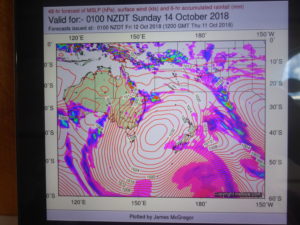
Our last trip into Suva was to clear out which was done quickly without any fuss in a little office within the dock area, tucked between the road and mesh fence and the hundreds of containers. “Immigration requires you to leave within 3 hours, ok?” We decided we could treat this comment with respect if not compliance as our plan was to depart early the next morning and we thought it unlikely any Immigration vessel would come looking for us as they didn’t even know where we were.
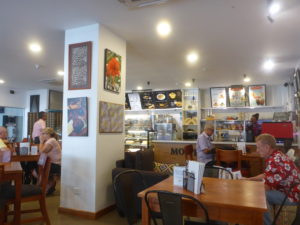
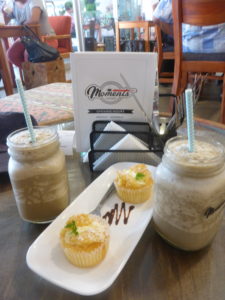
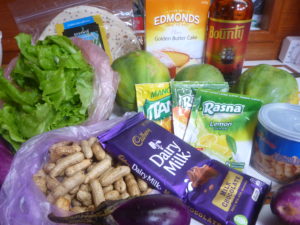
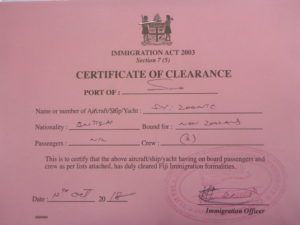
Rob fixed the inner forestay in position and hanked on the orange storm jib, last used for the same passage from Tonga two years ago and I did a big bake, hardboiled some eggs and stowed moveable items below for the passage.
We were nearly ready to leave this lovely place, with some regrets of course and a degree of apprehension that we feel before each deep sea passage no matter what the weather forecast, just wondering what was out there awaiting us.
So on Saturday 13th October we said farewell in our minds to the market ladies preparing to meet Meghan, Duchess of Sussex, the 1500 Fijian soldiers of the British Army, Mere and Jone our host family on Fulanga, Fiji – one of the 52 Commonwealth Countries working on numerous environmental projects and womens’ projects to assist them in small businesses and goodbye lovely Lami Bay; cannot understand why more cruisers don’t drop their hooks there.
